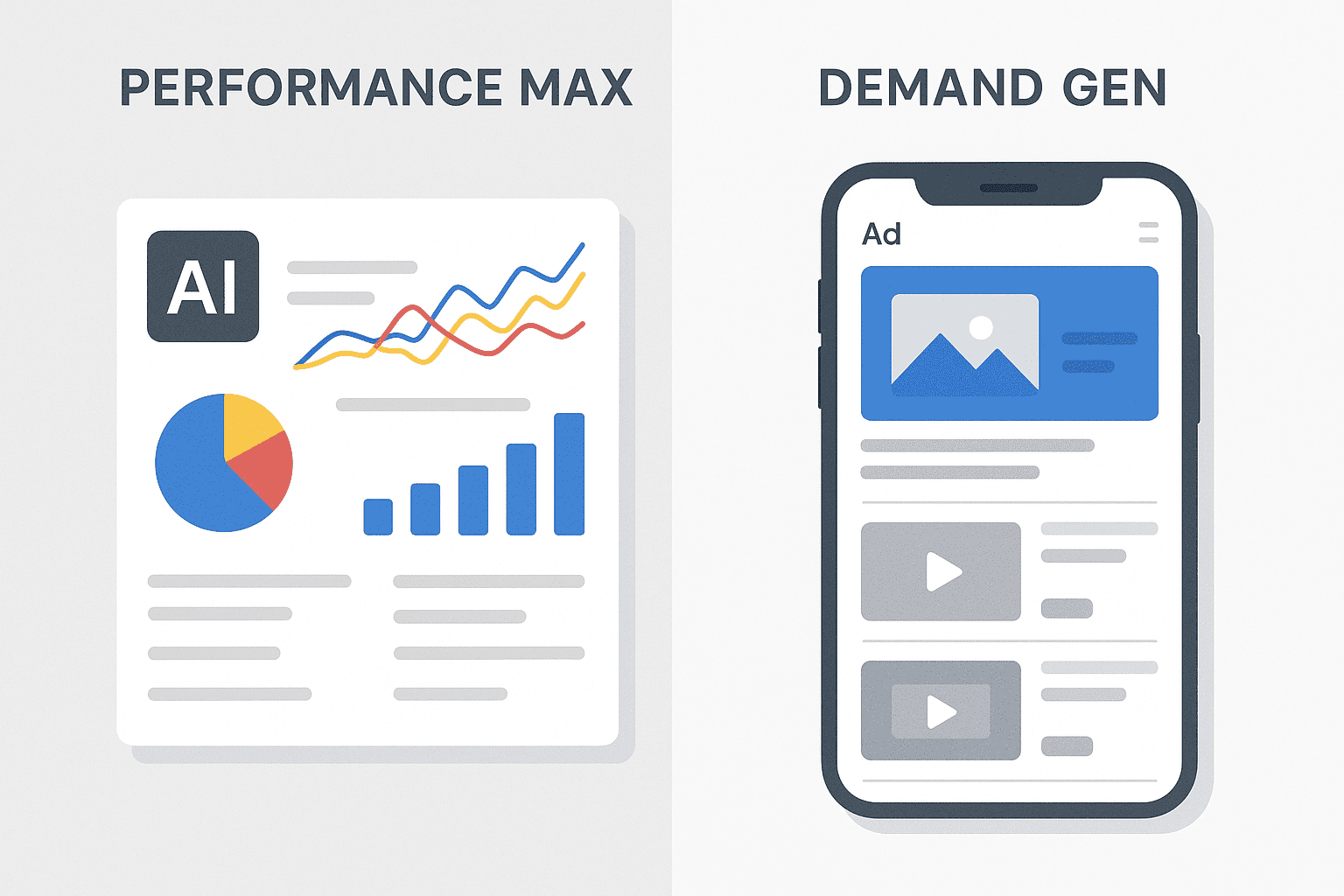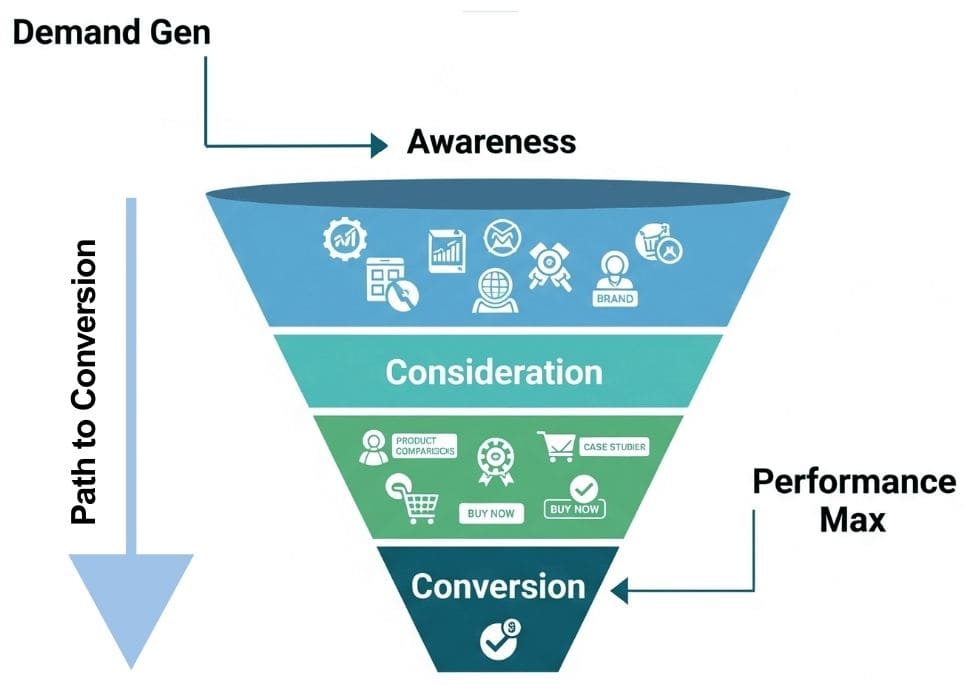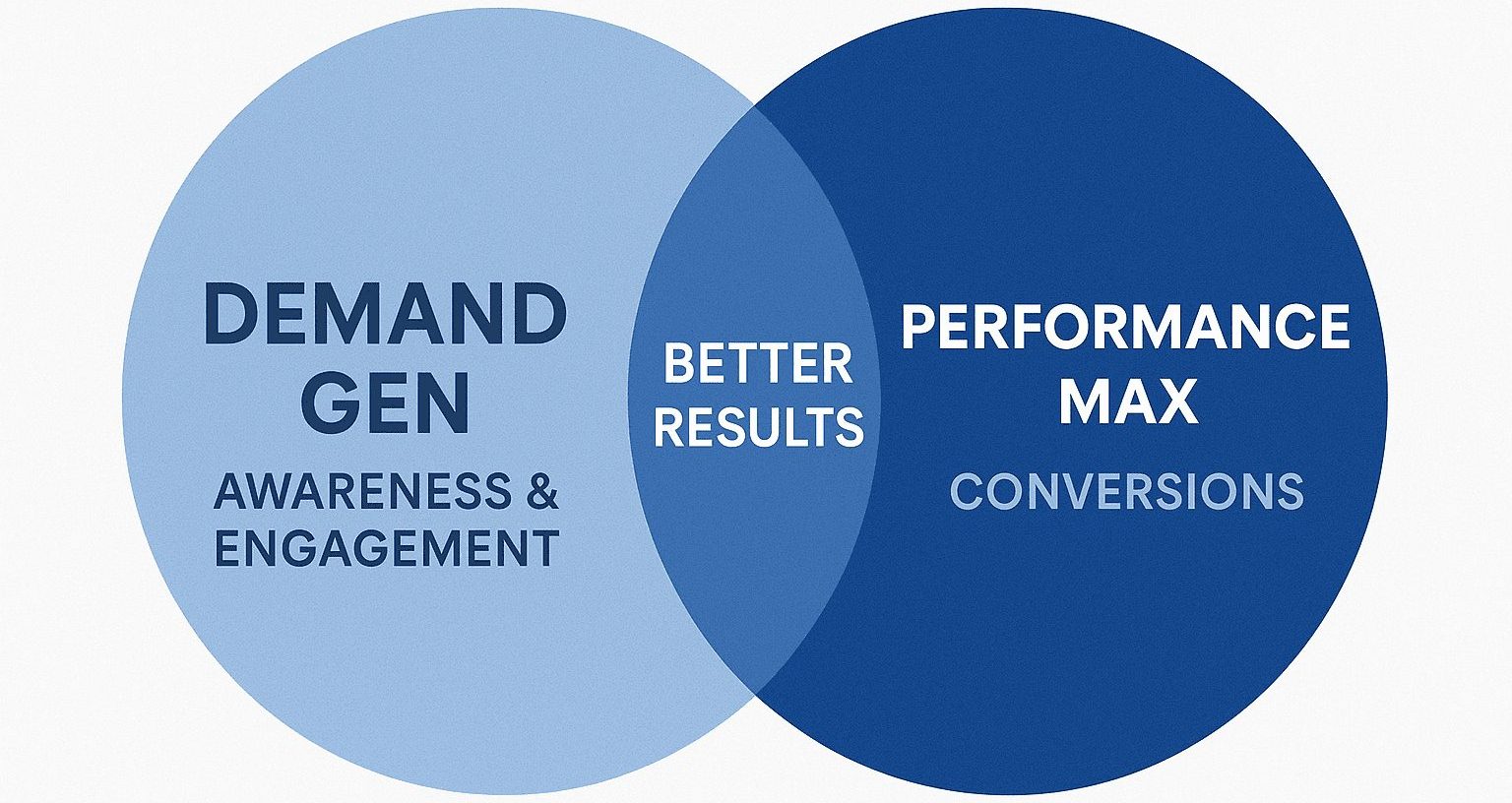
Introduction
Launched in late 2023, Performance Max and what evolved from Discovery, now known as Demand Gen, are two of Google’s most powerful advertising campaign types. Each serves distinct strategic goals: one excels at driving conversions across Google’s full inventory, the other focuses on generating awareness through visually engaging ads across immersive surfaces. This refreshed article explores how these campaign types compare in 2025 and how Google continues to refine their capabilities.

- Objectives & Audience Focus
- Performance Max (PMax)
Built to maximize conversions and conversion value across all Google channels (Search, Shopping, Display, YouTube, Discover, Gmail, Maps) using fully automated bidding and delivery powered by AI. - Demand Generation (Demand Gen)
Created to spark interest and build demand, particularly earlier in the funnel. It delivers rich, visually compelling ads across YouTube (including Shorts), Discover, Gmail, and now the Google Display Network. It is ideal for brand awareness and engagement.
- Performance Max (PMax)
- Placement & Ad Formats
- Performance Max (PMax)
Broad reach across all Google surfaces, including Search, Shopping, Display, YouTube, Discover, Gmail, Maps with dynamic formats like responsive search or display, video, image, and more. - Demand Generation (Demand Gen)
Focused on visually immersive inventory. Ads can be image, carousel, video (including Shorts), and product feed driven across YouTube, Discover, Gmail, and Display. This makes it highly native and engaging.
- Performance Max (PMax)
- Targeting & Control
- Performance Max (PMax)
Relies heavily on Google’s AI. Advertisers provide budget and goals, optionally audience signals (like customer lists), but Google autonomously tailors targeting. Recent updates added limited controls such as negative campaign level keywords, brand exclusions, device and age targeting, and a High Value New Customer mode leveraging Customer Match. - Demand Generation (Demand Gen)
Offers more direct control. You can manually define audiences (interests, demographics, lookalikes), select or exclude placements using expanded channel controls (launched in early 2025), and fine tune where ads show including YouTube Shorts, Discover, Gmail, and the Display Network.
- Performance Max (PMax)
- Optimization & Automation
- Performance Max (PMax)
Fully automated. Smart Bidding optimizes bids, assets, and placements across channels based on goals like conversions or ROAS. New features such as High Value Mode allow optimization toward valuable audiences (high LTV customers). - Demand Generation (Demand Gen)
Also AI powered, but with more manual levers. Creative A/B testing, asset preference anchoring, and migration tools (for transitioning from Video Action Campaigns) offer added flexibility. Early 2025 updates introduced creative tools like vertical image ads and video shortening, retail integrations with product feeds and local offers, and refined reporting.
- Performance Max (PMax)
- Reporting & Insights
- Performance Max (PMax)
Prioritizes ease and automation over diagnostic insight. Reporting often lacks granularity on placements and audiences, although the introduction of negative keyword and exclusion tools enhances control. - Demand Generation (Demand Gen)
Offers deeper transparency. New columns such as view through conversions aligned with social metrics, placement and audience performance breakdowns, and product level insights help marketers refine strategies more actively.
- Performance Max (PMax)
- Migration & Campaign Evolution
Demand Gen replaced both Discovery campaigns and Video Action Campaigns (VAC). Discovery campaigns were phased out starting late 2023 with full auto upgrade by early 2024. In mid 2025, Google is auto migrating VACs to Demand Gen, with manual migration tools available since Q1 2025.
- Strategic Considerations
- Complementary Roles
Use Demand Gen for top and mid funnel awareness and engagement via immersive formats and visual storytelling. Use Performance Max for bottom funnel conversion efficiency across all Google inventory. - Avoid Self Cannibalization
Performance Max can outbid and stall Demand Gen performance, particularly when both cover similar audiences or include product feeds optimized for conversions. Segregate audiences and goals to prevent overlap. - Best Practice Tip
Rely on Demand Gen for new customer acquisition and upper funnel engagement. Let Search and Shopping campaigns (your “primary campaigns”) own branded and high intent traffic. Use PMax and Demand Gen for prospecting rather than core revenue driving traffic.
- Complementary Roles

Conclusion
As of mid 2025, your original framework still holds strong but with important updates:
- Demand Gen has evolved into a more powerful, AI driven, creative first campaign type, with expanded control and reporting, especially for visual first strategies.
- Performance Max remains the go to for conversion driven, all encompassing automation, now with improved control and targeting options.
By aligning campaign type with funnel stage, creative assets, and audience control needs, while being mindful of overlap, you can harness the strengths of both to maximize impact.
